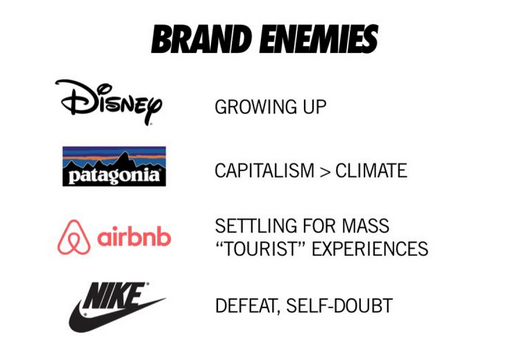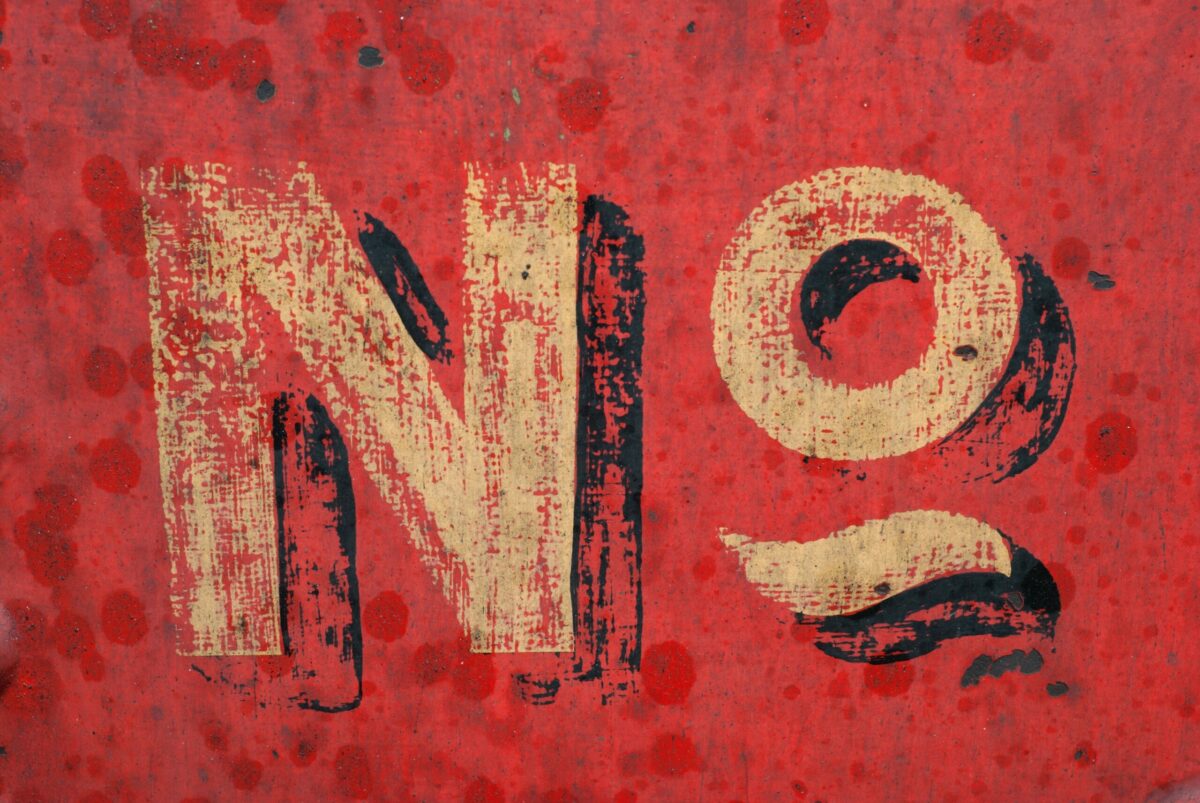It’s healthy to adopt a brand enemy. Handled well, having such an adversary works for your customers and your culture. Brand enemies are a powerful source of motivation and focus. It’s human nature to be united by the things we have in common and those we want to see change. But choose your enemy carefully and deliberately. It may just be that your best brand enemy is not the one you think of first.
In this post, we examine:
The link between enemy and identity
Defining a brand enemy
The connection to brand culture
Examples of a brand enemy
The six types of brand enemy
Eight examples of brand enemy
The link between enemy and identity
The word enemy itself derives from the Latin “inimicus”, meaning in effect “not a friend”. According to Vamik Volkan, our human inclination to identify people as friend or foe evolves from a deep instinct to protect our sense of self.
People who affirm what we believe and hold dear count as our friends. Those who threaten or subvert what we associate ourselves with are the ones we often label as enemies. When the things we value are threatened, we quickly revert to binary categorisation.
Friend or foe. One of us – or not.
While the phenomenon itself is interesting, what caught my attention was the alignment with the wider sense of identity.
Brands too are about identity and about coaxing people to associate with what they represent. It makes sense that the same divide could work in their favour. Brands can have enemies that they look to address externally. But they can also have enemies that they unite their culture against from the inside out. And of course, an enemy shared by all is a powerful and tribal dynamic.
Defining a brand enemy
First though, let’s be clear about what we mean by brand enemies. Unless you are a challenger brand or a brand looking to democratise a sector, enemies are not just rival brands. Your brand enemies are those elements in a market, from ideas to brands, that run counter to your greatest drivers. That makes them “not a friend” to your brand.
Distinctive brands choose to have distinctive enemies. An enemy for your brand could be another belief or an assumption. It could be: an action or a way of working; a state of the world. It might be a system. Potentially, it’s an injustice or an intolerance.
Whatever it is, it is something that your brand fundamentally opposes and wants to change because of who you are as a brand, and the way you present what you stand for, dictates that you do so. Ideally, enemies also galvanise consumers because they too want to see an end to the thing you’ve declared war on.
The connection to brand culture
MullenLowe CEO Kristen Cavallo has directly linked brand positioning, purpose and the defining of enemies: “Clients must understand what they stand against as a brand, not just their purpose. Defining your enemies can be more critical when positioning your company than your purpose. This can be a breakthrough in positioning yourself …”
In other words, positioning, purpose and having a brand enemy should hold a company accountable for what it believes and what it doesn’t believe in. All three need to be aligned in order for your position in the market to ring true.
Every brand needs an enemy so that it knows its place in the world. And so, the presence of a brand enemy can make its way into many different touchpoints of the core brand framework.
A good starting point can be “what should this brand nail on the church door?”. In 1517, it is said, monk Martin Luther nailed 95 dissents to the door of a Catholic church in Wittenburg, Germany disputing much of what faith was understood to stand for at the time.
Through the process, he not only made an enemy of the Catholic establishment, but also established the basis for what would become the Lutheran Church specifically, and arguably Protestantism generally. Historians may dispute whether this particular poster happened, but the symbolism is a powerful thought-starter. It invites the question, “What and who would make your list?”
Brands now operate in environments marked by polarisation
The step-up here is the demand for brands to choose to stand for (and against) something. In a wider environment characterised by increased polarisation, there is a natural tendency to avoid being seen as partisan.
Taking sides is a risky business. Brand managers don’t want boycotts, they don’t want hate-streams in their socials, they don’t want to be called out by politicians or to find themselves on the receiving end of claims that they are woke or not woke. And that has led many brands to find a nice, broad, homogeneous fence to sit on.
Choose with care
Just as you choose your friends, you should also choose your brand enemy with care. If you are clear about what you believe as a brand, you must also be clear about what you don’t believe and what you find unacceptable. The thing you as a branded culture collectively hate the most, and that everyone else around you seems to accept or even encourage, that’s your enemy.
But a brand enemy doesn’t have to be political or even controversial. It can be: the reason you started your business; an antidote to too many people’s experiences; a change for the better. It might represent actions or ideas that run contrary to what your brand believes in and aspires to.
Starbucks railed against bad coffee. Google has an enemy in things that can’t be found. It runs against everything they are striving to achieve. Red Bull ranks lack of excitement as an enemy. Apple has an enemy in the form of mass-produced boredom.
Jeremy Schumann has given some other great examples:

Some brands will choose to articulate their enemy directly. Some will do it quietly and within their own walls.
However – if you and all your competitors agree that something is unacceptable, that’s not an enemy, that’s a standard or a consensus or an industry opinion.
So, if you are unsure, where do you start to look for a brand enemy?
The six types of brand enemy
In broad terms, brand enemies fall into six camps:
- Tangible – something or some brand you want to specifically identify as undesirable
- Emotional – the emotional enemies for consumers that Graeme Robertson refers to
- Experiential – experiences that people find intolerable
- Communal – things that adversely affect specific communities of people
- Financial – things that don’t represent value for money or that feel like price-gouging
- Universal – the globally scaled issues that confront humanity
Eight examples of brand enemy
Here are eight suggestions. They can be used separately or in combination:
Let’s start with the ones that first come to mind:
Tangible
- Rival – brand rivalry forms much of the discourse whenever people talk about having brand enemies. Microsoft vs Apple, Coke vs Pepsi, Burger King vs McDonald’s, Avis vs Hertz, Holden vs Ford … With this approach, you focus on another brand and declare them the “enemy”. Then go about doing everything you can to outsell and outsmart them.
- Leader – this is the modus operandi for challenger brands. Find a brand more prominent than you, and position them as embodying the very things you will not tolerate. The goal is to unsettle and to game change – to shift what consumers prioritise in your favour in order for your brand to be able to play to its strengths.
Our recommendation however is almost always to look beyond the straight brand to brand rivalry, because that can rapidly become self-indulgent, and instead to look for a brand enemy that ordinary people who buy your products might want to see you tackle on their behalf. Here are some examples:
Emotional
- Moral – something happens in a market that you declare needs to be stamped out. It could be an environmental outcome from a common process, it could be a way of selling, it could be profit levels or unfair practices in a market that customers view as closed. Plastics are a pertinent example of an issue that has been elevated to a level of moral importance for some consumers. Eliminating or minimising the harm from a declared brand enemy in your supply chain is an example of this idea in action.
Experiential
- Effort – when something takes too long or the process is too complex. Promising to un-confuse things for your customers is a powerful motivation, particularly if it is something they are passionate about.
Communal
- Social – similar to finding a moral enemy, but more focused on dealing with social outcomes that people want to see change. These can range from poverty to forced labour to countries or companies of origin that your brand audience want nothing to do with. The enemy of Red Cross is hurt. The enemy of Save the Children is child mortality. Equally, a social brand enemy can be the endorsement of an idea that others are looking to dilute or close down. The enemy of my enemy …
Financial
- Cost – when something is perceived as too expensive, there is always the opportunity to present that cost as unreasonable and to offer a more accessible alternative. Of course challenger and democratiser brands do this all the time – and sometimes it can just lead to a race to the bottom.I pick this brand enemy very carefully, and normally from the point of view of how value can be added rather than price subtracted. One very effective combination is to combine cost and moral as an enemy, where child labour is involved for example.
But it can also work the other way – where low cost is the enemy. I always loved Stellar Artois’ “Reassuringly expensive” line because it called out trashy, cheap beer as an enemy in order to position Stellar Artois as the Belgian luxury alternative.
- Quality – calling out quality, or rather the lack of quality or a decline in quality, plays directly into customers’ fear of missing out. Entitlement is a powerful human motivation because no-one wants to feel that others are getting or gaining at their expense.
Conversely, customers can see a lift in quality (especially when accompanied by a lift in asking price) as over-pricing and over-featuring. Sometimes people just want things the way they were. In which case, unnecessary change (with its related resentments of unfamiliar, too difficult, unrecognisable and unasked for) becomes the enemy.
Universal
- Outcome – anything that falls short of what customers want or expect in their life makes for a powerful brand enemy. L’Oreal called out a life-less-lived as an enemy of their brand more than 50 years ago with “Because you’re worth it”. And in 2004 of course, Dove combined outcome and social enemies when they went after unrealistic expectations from the beauty industry and what body image was doing to the confidence of girls and women.
Find your brand enemy
Identifying a brand enemy is an important part of forming a Principled Culture. Alongside your purpose, vision, role in market and values, your brand enemy defines what your people come to work to challenge and change in the world.
If you want to focus on something specific, like identifying your brand enemy, use our brand culture workshop approach to capture and codify key defining aspects of your culture.
Or, if you’re ready to take sides in writing, ask us to capture what fires you up in a bring-it-in, bring-it-on brand manifesto.
Acknowledgements
Photo by Gemma Evans


7 thoughts on “Know thy brand enemy”